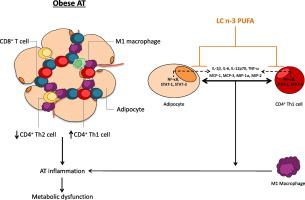The Journal of Nutritional Biochemistry ( IF 4.8 ) Pub Date : 2020-08-19 , DOI: 10.1016/j.jnutbio.2020.108488 Danyelle M Liddle 1 , Amber L Hutchinson 1 , Jennifer M Monk 1 , Anna A DeBoer 1 , David W L Ma 1 , Lindsay E Robinson 1

|
Obese adipose tissue (AT) inflammation is partly driven by accumulation of CD4+ T helper (Th)1 cells and reduced Th2 and T regulatory (Treg) subsets, which promotes macrophage chemotaxis and ensuing AT metabolic dysfunction. This study investigated CD4+ T cell/adipocyte cytokine-mediated paracrine interactions (cross-talk) as a target for dietary intervention to mitigate obese AT inflammation. Using an in vitro co-culture model designed to recapitulate CD4+ T cell accumulation in obese AT (5% of stromal vascular cellular fraction), 3 T3-L1 adipocytes were co-cultured with purified splenic CD4+ T cells from C57Bl/6 mice consuming one of two isocaloric diets containing either 10% w/w safflower oil (control, CON) or 7% w/w safflower oil+3% w/w fish oil (FO) for 4 wk. (n=8–11/diet). The FO diet provided 1.9% kcal from the long-chain (LC) n-3 polyunsaturated fatty acids (PUFA) EPA and DHA, a dose that can be achieved by supplementation. Co-cultures were stimulated for 48 h with lipopolysaccharide (LPS) to mimic in vivo obese endotoxin levels, or with conditioned media collected from LPS-stimulated visceral AT isolated from CON-fed mice. In both stimulation conditions, FO reduced mRNA expression and/or secreted protein levels of Th1 markers (T-bet, IFN-γ) and increased Th2 markers (GATA3, IL-4), concomitant with reduced inflammatory cytokines (IL-1β, IL-6, IL-12p70, TNF-α), macrophage chemokines (MCP-1, MCP-3, MIP-1α, MIP-2), and levels of activated central regulators of inflammatory signaling (NF-κB, STAT-1, STAT-3) (P<.05). Therefore, CD4+ T cell/adipocyte cross-talk represents as a potential target for LC n-3 PUFA to mitigate obese AT inflammation.
中文翻译:

日粮长链n-3 PUFA可减轻肥胖脂肪组织共培养模型中CD4 + T细胞/脂肪细胞的炎症相互作用。
肥胖脂肪组织(AT)的炎症部分是由CD4 + T辅助(Th)1细胞的积累以及Th2和T调节(Treg)子集减少引起的,这促进了巨噬细胞的趋化性并导致AT代谢功能障碍。这项研究调查了CD4 + T细胞/脂肪细胞细胞因子介导的旁分泌相互作用(串扰)作为饮食干预减轻肥胖AT炎症的目标。使用旨在概括肥胖AT(基质血管细胞分数的5%)中CD4 + T细胞积累的体外共培养模型,将3枚T3-L1脂肪细胞与来自C57Bl / 6小鼠的纯化脾CD4 + T细胞共培养食用两种等热量饮食中的一种,其中两种饮食的含量均为10%w / w红花油(对照,CON)或7%w / w红花油+ 3%w / w鱼油(FO),连续4周。(n = 8-11 /饮食)。FO饮食从长链(LC)n-3多不饱和脂肪酸(PUFA)EPA和DHA中提供了1.9%kcal,该剂量可以通过补充获得。用脂多糖(LPS)刺激共培养48小时以模拟体内肥胖内毒素水平,或使用从CON喂养的小鼠中分离的LPS刺激的内脏AT收集的条件培养基。在两种刺激条件下,FO均可降低Th1标记(T-bet,IFN-γ)的mRNA表达和/或分泌的蛋白质水平,并增加Th2标记(GATA3,IL-4),并伴有炎性细胞因子(IL-1β,IL)减少-6,IL-12p70,TNF-α),巨噬细胞趋化因子(MCP-1,MCP-3,MIP-1α,MIP-2)和激活的炎症信号中央调节剂(NF-κB,STAT-1, STAT-3)(P <.05)。因此,CD4 + T细胞/脂肪细胞的串扰代表LC n-3 PUFA减轻肥胖AT炎症的潜在目标。











































 京公网安备 11010802027423号
京公网安备 11010802027423号